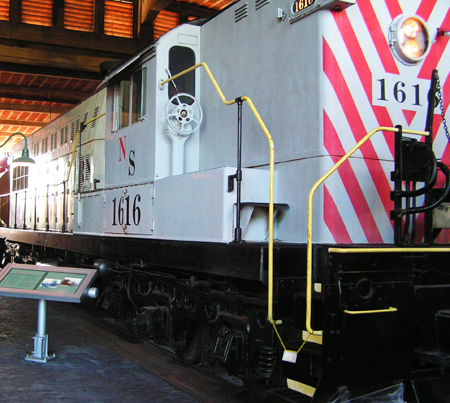Norfolk Southern Railroad
The Norfolk Southern Railroad was founded on New Year's Day 1883, with its original road running from Norfolk, Va., to Elizabeth City, N.C. Its predecessor, the Elizabeth City & Norfolk Railroad, chartered in 1870, had completed tracks south to Edenton on the Albemarle Sound in 1881. This was a continuation of a commercial connection between these points dating back to the Dismal Swamp Canal efforts of the late 1700s. In 1891 the road was reorganized as the Norfolk & Southern Railroad, but after 1900 consolidations brought back the name Norfolk Southern and the system was extended to New Bern, Raleigh, and Charlotte.
In 1907 work commenced on a five-mile trestle to cross the sound, which by January 1910 cost more than $1 million. The railroad lacked sufficient funds to adequately maintain the trestle, which perhaps led to its collapse in 1957-an accident that dropped a train into the sound and killed two crew members. But the trestle opened the way to connect with points in Piedmont North Carolina. Several of the state's smaller lines became part of the Norfolk Southern, including the Winston-Salem Southbound Railway, Raleigh & Western Railway (originally the Egypt Railway), Raleigh & Cape Fear Railway, North Carolina Midland Railroad, and Charlotte, Columbia, and Augusta Railroad. The line eventually ran from Norfolk to both Charlotte and Greensboro via Raleigh. In 1961 the company offices were moved from Norfolk to Raleigh.
The Norfolk Southern was noted for transporting agricultural and lumber products, and it aided in industrial development, especially in the rural counties of eastern North Carolina. At times the railroad offered passenger service, but after 1948 it was completely a freight road. Never strong financially, the company went into receivership on several occasions. On 1 Jan. 1974 the Norfolk Southern united with the Southern Railway System but continued to operate under its own name. At the time of the merger, the Norfolk Southern consisted of nearly 1,000 cars and engines and 624 miles of track. In 1982, when Southern Railway merged with the Norfolk & Western Railroad, the railroad became a part of the massive Norfolk Southern Corporation.
In 1990 the Norfolk Southern Corporation leased the old Elizabeth City & Norfolk line between Chesapeake, Va., and Edenton, N.C., to RailTex, Inc., a short-line company based in Texas that began operating the line as the Chesapeake & Albemarle Railroad (C&A) under Norfolk Southern's "Thoroughbred Shortline Program." The 73-mile C&A was a member of the RailAmerica, Inc., family of railroads headquartered in Boca Raton, Fla., which also included the North Carolina & Virginia Railroad. The C&A linked up with the Norfolk Southern and another giant transportation company, CSX Corporation, at Norfolk.
By the early 2000s the Norfolk Southern Corporation was a holding company headquartered in Norfolk that owned and managed the Norfolk Southern Railway as well as a telecommunications firm and a natural-resource company. The railroad system, which began operating about 7,200 miles of Conrail routes in 1999, extended approximately 21,800 miles across 22 states, the District of Columbia, and Canada. The Norfolk Southern operated 1,450 miles, or 43 percent, of North Carolina's rail system. One of its north-south main lines connected the Northeast and Midwest with Atlanta via Danville, Va., Greensboro, and Charlotte. A second north-south main line linked Tennessee with Spartanburg, S.C., through Asheville, while an east-west main line connected Salisbury and Asheville. Seven other routes, either owned or leased by the Norfolk Southern, served eastern and central North Carolina. The Norfolk Southern Corporation also employed nearly 1,500 people in North Carolina and carried 593,712 carloads for 723 North Carolina industries.
References:
Burke Davis, The Southern Railway: Road of the Innovators (1985).
George H. Drury, The Historical Guide to North American Railroads (1985).
Edward A. Lewis, American Shortline Railway Guide (1996).
Robert Reisweber, "The Norfolk Southern Railroad," Green Light (April 1976).
Additional Resources:
Norfolk Southern Railroad official website: http://www.nscorp.com/
"An act to change the name of the Elizabeth City and Norfolk Railroad Company to the Norfolk Southern Railroad Company." Laws and Resolutions State of North Carolina Passed By The General Assembly Session Of 1883. Raleigh, N.C.: Ashe and Gatling. 1883. https://digital.ncdcr.gov/Documents/Detail/laws-and-resolutions-of-the-state-of-north-carolina-passed-by-the-general-assembly-at-its-session-1883/3889545?item=3898741 (accessed August 1, 2012).
Borkowski, Richard C. Norfolk Southern Railway. Minneapolis, Minn.: Voyageur Press. 2008. http://books.google.com/books?id=V7SxfB1uHzwC&lpg=PP1&pg=PP1#v=onepage&q&f=false (accessed August 1, 2012).
"Norfolk Southern Railroad Company History." [unknown]. http://collections.ncdcr.gov/RediscoveryProficioPublicSearch/ShowItem.aspx?25568+ (accessed August 3, 2012).
Jefferys, Grady. "Norfolk Southern Expanding Service: Puffer Bellies Gone to Rest." The News and Observer [Raleigh, N.C.]. April 12, 1964. "Railroads - North Carolina" Vertical Reference File, Government and Heritage Library, North Carolina.
"Carolina Rails," Our State, August 2011. https://digital.ncdcr.gov/Documents/Detail/our-state/1120024
Image Credits:
"Locomotive, Accession #: S.1985.168.1." 1955. North Carolina Historic Sites.
1 January 2006 | Bingham, Warren L.; Lassiter, Wingate
